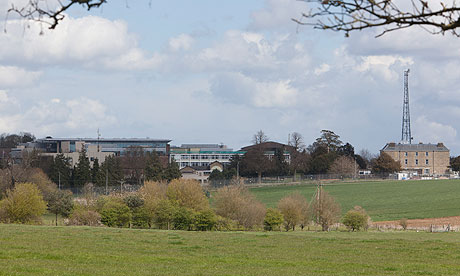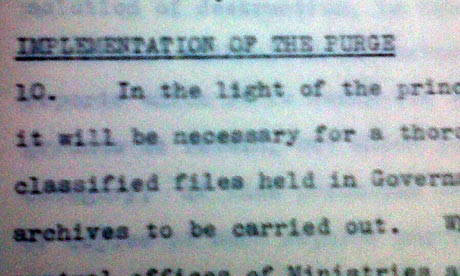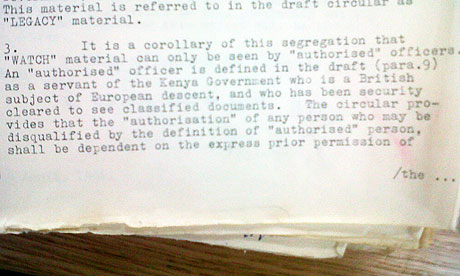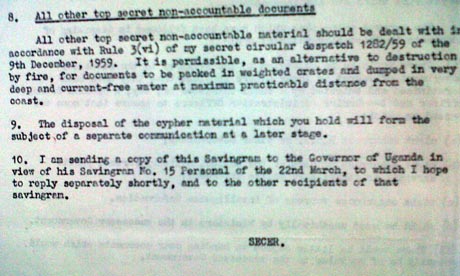Britain destroyed records of colonial crimes
Review finds thousands of papers detailing shameful acts were culled, while others were kept secret illegally

Hanslope Park, where the Foreign Office kept a secret archive of colonial papers. Photograph: Martin Argles for the Guardian
Thousands of documents detailing some of the most shameful acts and crimes committed during the final years of the British empire were systematically destroyed to prevent them falling into the hands of post-independence governments, an official review has concluded.
Those papers that survived the purge were flown discreetly to Britain where they were hidden for 50 years in a secret Foreign Office archive, beyond the reach of historians and members of the public, and in breach of legal obligations for them to be transferred into the public domain.
The archive came to light last year when a group of Kenyans detained and allegedly tortured during the Mau Mau rebellion won the right to sue the British government. The Foreign Office promised to release the 8,800 files from 37 former colonies held at the highly-secure government communications centre at Hanslope Park in Buckinghamshire.
The historian appointed to oversee the review and transfer, Tony Badger, master of Clare College, Cambridge, says the discovery of the archive put the Foreign Office in an "embarrassing, scandalous" position. "These documents should have been in the public archives in the 1980s," he said. "It's long overdue." The first of them are made available to the public on Wednesday at the National Archive at Kew, Surrey.
The papers at Hanslope Park include monthly intelligence reports on the "elimination" of the colonial authority's enemies in 1950s Malaya; records showing ministers in London were aware of the torture and murder of Mau Mau insurgents in Kenya, including a case of aman said to have been "roasted alive"; and papers detailing the lengths to which the UK went to forcibly remove islanders from Diego Garcia in the Indian Ocean.
However, among the documents are a handful which show that many of the most sensitive papers from Britain's late colonial era were not hidden away, but simply destroyed. These papers give the instructions for systematic destruction issued in 1961 after Iain Macleod, secretary of state for the colonies, directed that post-independence governments should not get any material that "might embarrass Her Majesty's government", that could "embarrass members of the police, military forces, public servants or others eg police informers", that might compromise intelligence sources, or that might "be used unethically by ministers in the successor government".
Among the documents that appear to have been destroyed were: records of the abuse of Mau Mau insurgents detained by British colonial authorities, who were tortured and sometimes murdered; reports that may have detailed the alleged massacre of 24 unarmed villagers in Malaya by soldiers of the Scots Guards in 1948; most of the sensitive documents kept by colonial authorities in Aden, where the army's Intelligence Corps operated a secret torture centre for several years in the 1960s; and every sensitive document kept by the authorities in British Guiana, a colony whose policies were heavily influenced by successive US governments and whose post-independence leader was toppled in a coup orchestrated by the CIA.
The documents that were not destroyed appear to have been kept secret not only to protect the UK's reputation, but to shield the government from litigation. If the small group of Mau Mau detainees are successful in their legal action, thousands more veterans are expected to follow.
It is a case that is being closely watched by former Eoka guerillas who were detained by the British in 1950s Cyprus, and possibly by many others who were imprisoned and interrogated between 1946 and 1967, as Britain fought a series of rearguard actions across its rapidly dimishing empire.
The documents show that colonial officials were instructed to separate those papers to be left in place after independence – usually known as "Legacy files" – from those that were to be selected for destruction or removal to the UK. In many colonies, these were described as watch files, and stamped with a red letter W.
The papers at Kew depict a period of mounting anxiety amid fears that some of the incriminating watch files might be leaked. Officials were warned that they would be prosecuted if they took any any paperwork home – and some were. As independence grew closer, large caches of files were removed from colonial ministries to governors' offices, where new safes were installed.
In Uganda, the process was codenamed Operation Legacy. In Kenya, a vetting process, described as "a thorough purge", was overseen by colonial Special Branch officers.
 Photograph: The National Archives Clear instructions were issued that no Africans were to be involved: only an individual who was "a servant of the Kenya government who is a British subject of European descent" could participate in the purge.
Photograph: The National Archives Clear instructions were issued that no Africans were to be involved: only an individual who was "a servant of the Kenya government who is a British subject of European descent" could participate in the purge.
 Photograph: The National Archives Painstaking measures were taken to prevent post-independence governments from learning that the watch files had ever existed. One instruction states: "The legacy files must leave no reference to watch material. Indeed, the very existence of the watch series, though it may be guessed at, should never be revealed."
Photograph: The National Archives Painstaking measures were taken to prevent post-independence governments from learning that the watch files had ever existed. One instruction states: "The legacy files must leave no reference to watch material. Indeed, the very existence of the watch series, though it may be guessed at, should never be revealed."
When a single watch file was to be removed from a group of legacy files, a "twin file" – or dummy – was to be created to insert in its place. If this was not practicable, the documents were to be removed en masse. There was concern that Macleod's directions should not be divulged – "there is of course the risk of embarrassment should the circular be compromised" – and officials taking part in the purge were even warned to keep their W stamps in a safe place.
Many of the watch files ended up at Hanslope Park. They came from 37 different former colonies, and filled 200 metres of shelving. But it is becoming clear that much of the most damning material was probably destroyed. Officials in some colonies, such as Kenya, were told that there should be a presumption in favour of disposal of documents rather than removal to the UK – "emphasis is placed upon destruction" – and that no trace of either the documents or their incineration should remain. When documents were burned, "the waste should be reduced to ash and the ashes broken up".
Some idea of the scale of the operation and the amount of documents that were erased from history can be gleaned from a handful of instruction documents that survived the purge. In certain circumstances, colonial officials in Kenya were informed, "it is permissible, as an alternative to destruction by fire, for documents to be packed in weighted crates and dumped in very deep and current-free water at maximum practicable distance from the coast".
 Photograph: The National Archives Documents that survive from Malaya suggest a far more haphazard destruction process, with relatively junior officials being permitted to decide what should be burned and what should be sent to London.
Photograph: The National Archives Documents that survive from Malaya suggest a far more haphazard destruction process, with relatively junior officials being permitted to decide what should be burned and what should be sent to London.
Dr Ed Hampshire, diplomatic and colonial record specialist at the National Archive, said the 1,200 files so far transferred from Hanslope Park represented "gold dust" for historians, with the occasional nugget, rather than a haul that calls for instant reinterpretation of history. However, only one sixth of the secret archive has so far been transferred. The remainder are expected to be at Kew by the end of 2013.
Those papers that survived the purge were flown discreetly to Britain where they were hidden for 50 years in a secret Foreign Office archive, beyond the reach of historians and members of the public, and in breach of legal obligations for them to be transferred into the public domain.
The archive came to light last year when a group of Kenyans detained and allegedly tortured during the Mau Mau rebellion won the right to sue the British government. The Foreign Office promised to release the 8,800 files from 37 former colonies held at the highly-secure government communications centre at Hanslope Park in Buckinghamshire.
The historian appointed to oversee the review and transfer, Tony Badger, master of Clare College, Cambridge, says the discovery of the archive put the Foreign Office in an "embarrassing, scandalous" position. "These documents should have been in the public archives in the 1980s," he said. "It's long overdue." The first of them are made available to the public on Wednesday at the National Archive at Kew, Surrey.
The papers at Hanslope Park include monthly intelligence reports on the "elimination" of the colonial authority's enemies in 1950s Malaya; records showing ministers in London were aware of the torture and murder of Mau Mau insurgents in Kenya, including a case of aman said to have been "roasted alive"; and papers detailing the lengths to which the UK went to forcibly remove islanders from Diego Garcia in the Indian Ocean.
However, among the documents are a handful which show that many of the most sensitive papers from Britain's late colonial era were not hidden away, but simply destroyed. These papers give the instructions for systematic destruction issued in 1961 after Iain Macleod, secretary of state for the colonies, directed that post-independence governments should not get any material that "might embarrass Her Majesty's government", that could "embarrass members of the police, military forces, public servants or others eg police informers", that might compromise intelligence sources, or that might "be used unethically by ministers in the successor government".
Among the documents that appear to have been destroyed were: records of the abuse of Mau Mau insurgents detained by British colonial authorities, who were tortured and sometimes murdered; reports that may have detailed the alleged massacre of 24 unarmed villagers in Malaya by soldiers of the Scots Guards in 1948; most of the sensitive documents kept by colonial authorities in Aden, where the army's Intelligence Corps operated a secret torture centre for several years in the 1960s; and every sensitive document kept by the authorities in British Guiana, a colony whose policies were heavily influenced by successive US governments and whose post-independence leader was toppled in a coup orchestrated by the CIA.
The documents that were not destroyed appear to have been kept secret not only to protect the UK's reputation, but to shield the government from litigation. If the small group of Mau Mau detainees are successful in their legal action, thousands more veterans are expected to follow.
It is a case that is being closely watched by former Eoka guerillas who were detained by the British in 1950s Cyprus, and possibly by many others who were imprisoned and interrogated between 1946 and 1967, as Britain fought a series of rearguard actions across its rapidly dimishing empire.
The documents show that colonial officials were instructed to separate those papers to be left in place after independence – usually known as "Legacy files" – from those that were to be selected for destruction or removal to the UK. In many colonies, these were described as watch files, and stamped with a red letter W.
The papers at Kew depict a period of mounting anxiety amid fears that some of the incriminating watch files might be leaked. Officials were warned that they would be prosecuted if they took any any paperwork home – and some were. As independence grew closer, large caches of files were removed from colonial ministries to governors' offices, where new safes were installed.
In Uganda, the process was codenamed Operation Legacy. In Kenya, a vetting process, described as "a thorough purge", was overseen by colonial Special Branch officers.
 Photograph: The National Archives Clear instructions were issued that no Africans were to be involved: only an individual who was "a servant of the Kenya government who is a British subject of European descent" could participate in the purge.
Photograph: The National Archives Clear instructions were issued that no Africans were to be involved: only an individual who was "a servant of the Kenya government who is a British subject of European descent" could participate in the purge. Photograph: The National Archives Painstaking measures were taken to prevent post-independence governments from learning that the watch files had ever existed. One instruction states: "The legacy files must leave no reference to watch material. Indeed, the very existence of the watch series, though it may be guessed at, should never be revealed."
Photograph: The National Archives Painstaking measures were taken to prevent post-independence governments from learning that the watch files had ever existed. One instruction states: "The legacy files must leave no reference to watch material. Indeed, the very existence of the watch series, though it may be guessed at, should never be revealed."When a single watch file was to be removed from a group of legacy files, a "twin file" – or dummy – was to be created to insert in its place. If this was not practicable, the documents were to be removed en masse. There was concern that Macleod's directions should not be divulged – "there is of course the risk of embarrassment should the circular be compromised" – and officials taking part in the purge were even warned to keep their W stamps in a safe place.
Many of the watch files ended up at Hanslope Park. They came from 37 different former colonies, and filled 200 metres of shelving. But it is becoming clear that much of the most damning material was probably destroyed. Officials in some colonies, such as Kenya, were told that there should be a presumption in favour of disposal of documents rather than removal to the UK – "emphasis is placed upon destruction" – and that no trace of either the documents or their incineration should remain. When documents were burned, "the waste should be reduced to ash and the ashes broken up".
Some idea of the scale of the operation and the amount of documents that were erased from history can be gleaned from a handful of instruction documents that survived the purge. In certain circumstances, colonial officials in Kenya were informed, "it is permissible, as an alternative to destruction by fire, for documents to be packed in weighted crates and dumped in very deep and current-free water at maximum practicable distance from the coast".
 Photograph: The National Archives Documents that survive from Malaya suggest a far more haphazard destruction process, with relatively junior officials being permitted to decide what should be burned and what should be sent to London.
Photograph: The National Archives Documents that survive from Malaya suggest a far more haphazard destruction process, with relatively junior officials being permitted to decide what should be burned and what should be sent to London.Dr Ed Hampshire, diplomatic and colonial record specialist at the National Archive, said the 1,200 files so far transferred from Hanslope Park represented "gold dust" for historians, with the occasional nugget, rather than a haul that calls for instant reinterpretation of history. However, only one sixth of the secret archive has so far been transferred. The remainder are expected to be at Kew by the end of 2013.
No comments:
Post a Comment